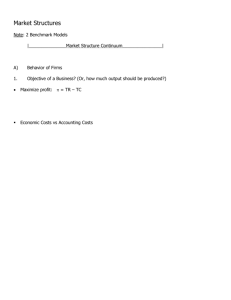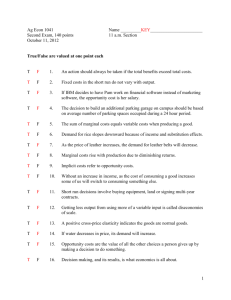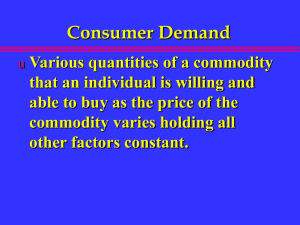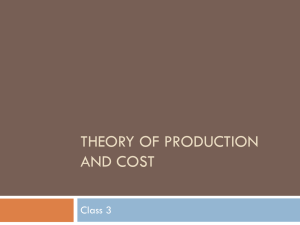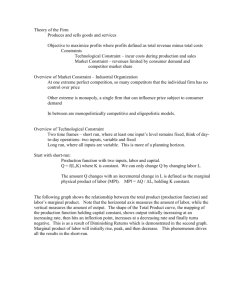Costs Curves Diminishing Returns
advertisement
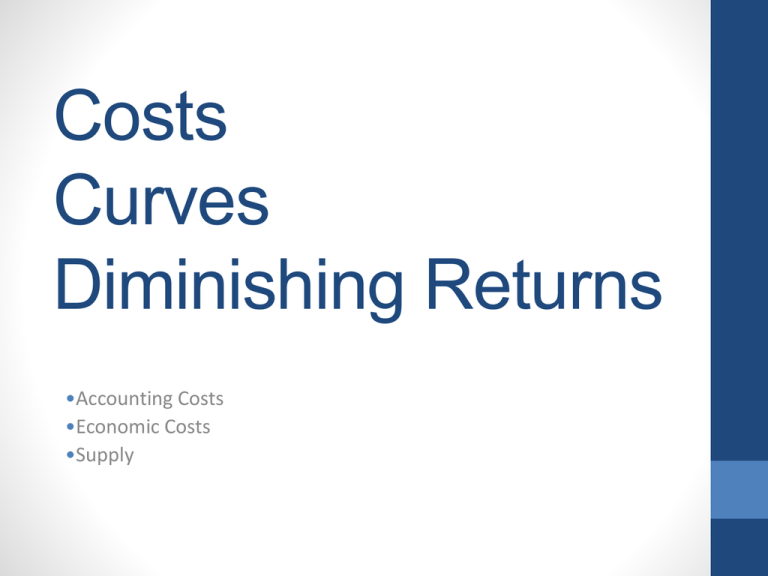
Costs Curves Diminishing Returns •Accounting Costs •Economic Costs •Supply ACCOUNTING COSTS • Accounting costs are monetary (usually explicit). • Accounting profit = Revenue – Accounting costs. ECONOMIC COSTS • Economic costs = accounting costs + opportunity costs. • Economic profit = revenue – economic costs. • Economic profit = revenue – (accounting costs + opportunity costs). ECONOMIC COSTS • Economic costs = accounting costs + opportunity costs. • • In economic analysis we use economic costs. • To make a wise decision we need to consider all costs and not only monetary costs. • Opportunity costs should be considered as they have an important bearing on our decision making. These include opportunity cost for resources owned by the firm itself. OPPORTUNITY COSTS • Bill owns a farm worth $1m. His yearly revenue is $100,000 and his expenses are $60,000. The current interest rate is 5% for savings. What is Bill’s accounting profit and what is his economic profit? Accounting profit $$40,000 Economic profit -($10,000) OPPORTUNITY COSTS • Chen runs her own business. She receives no wage or salary. She could work full-time for $25,000pa. Her business revenue for last year was $30,000 and her expenses $10,000. What is her accounting profit and her economic profit? Accounting profit $20000 Economic profit -($5000) OPPORTUNITY COSTS • Tao must travel from Wellington to Auckland for business. Tao is paid $20 per hour and he must travel in work time. Prices and times are: Which is cheapest? Mode Price $ Hours Plane $150 1 Car $100 6 Bus $70 10 Plane is cheapest. If we consider opportunity costs, total cost for plane travel is $170 – much cheaper than the other options. Economic costs in more detail • Rent- Economic return to land (return to any factor that is in fixed supply) • Wages- Economic return to labour. It includes all ways people a compensated for providing their time, efforts and skills. (except for enterprise) • Interest- Economic return on capital. • Profit- Economic return to enterprise for taking risk. It is the reward to those who run the risk of failure when they bring together all the other factors of production Do this Now • Last year Mona had a job as a manager for a fishing company, which paid her $65,000 a year, • She had $80,000 in savings, which gave her a rate of return of 10%. • She thought she could do better by going fishing herself, so gave up her job and invested $80,000 of her own money in buying a fishing boat and quota. • By the end of the first year she had sold $140,000 worth of fish and her costs of running the business had been $70,000. She expected the costs to be quite high in the first year, because she was getting the business established, but though these would fall in future years. • • • 1. Calculate her accounting profit 2. Calculate her economic profit 3. Which are always greater? Economic or accounting profits? Explain Answers! • 1. Calculate her accounting profit Revenue - Accounting costs 140,000 – 70,000 = 70,000 • 2. Calculate her economic profit Revenue – Economic Costs (accounting costs + opportunity costs) 140,000 – 70,000 – 65,000- (80,000 x0.10) = -3000 • 3. Which are always greater? Economic or accounting profits? Explain • Accounting profits are equal to Revenue minus accounting costs. Economic profits are equal to revenue minus accounting costs and opportunity costs. Thus Accounting profits will always be greater than Economic profits due to economic profits taking into account an extra cost, opportunity costs. Fixed costs are costs that do not vary with output Q FC VC 0 100 1 100 2 100 3 100 TC Fixed costs are costs that do not vary with output Variable costs are costs that increase as output increases Q FC VC TC 0 100 1 100 30 2 100 50 3 100 80 0 Fixed costs are costs that do not vary with output Q FC VC TC Variable costs are costs that increase as output increases 0 100 1 100 30 130 Total costs = Fixed + Variable costs 2 100 50 150 3 100 80 180 0 100 FC, VC & TC Fixed costs are costs that do not vary with output TC Costs($) Variable costs are costs that increase as output increases Total costs = Fixed + Variable costs VC FC Quantity Average and Marginal Cost Outpu t (Q) 0 Total Cost 100 Average Marginal Cost Cost - 1 200 200 100 2 320 160 120 3 420 140 100 4 640 160 220 5 1100 220 460 AC = TC/Q Average and Marginal Cost Outpu t (Q) 0 Total Cost 100 Average Marginal AC = TC/Q Cost Cost MC = TC2 - TC1 200 100 1 200 2 320 160 120 3 420 140 100 4 640 160 220 5 1100 220 460 Starter Activity Number of people in the Total Product group (Workers) Marginal Product 1 2 3 4 We will assume all groups are equally skilled, so the marginal product is the difference between group one’s total and group two’s total product. Graph the number of workers on the horizontal axis against the number of blocks sorted on the vertical axis. What do you notice? Short-run costs The short run, which our particular concern, is a period when at least one input to the production process is fixed. This means that in the short run all production will be subject to the law of diminishing return. fig In economics we distinguish between various time periods - ie short and long run. Diminishing Returns The law of diminishing returns states that where additional units of a variable input are added to a fixed amount of another input, the additional output, or marginal product, will eventually fall. Diminishing Returns Fixed Input Capital Cement Mixer Variable Input Labour Bricklayers AC TP (Q) MP Returns (per brick) MC (per brick) 1 0 0 1 1 70 70 Increasing 6 6 1 2 210 140 Increasing 4 3 1 3 420 210 Increasing 3 2 1 4 630 210 Constant 2.67 2 1 5 770 140 Diminishing 2.73 3 1 6 840 70 Diminishing Fixed Input Variable input 3 The additional output(MP) eventually falls 6 The Shape of the MC curve Costs($) MC decreases initially because of increasing returns MC Note: always plot the MC curve at the mid-point! MC increases because of diminishing returns Quantity The Shape of Average Cost Curves Costs($) FC are constant so AFC will continually decline as FC are spread over increasing output FC AFC Quantity The Shape of Average Cost Curves Costs($) AC decreases because of short run economies: AC •Technical •Marketing AFC •Managerial •Financial Quantity The Shape of Average Cost Curves Costs($) AC increases as short run diseconomies set in. AC AFC Quantity The Shape of Average Cost Curves Costs($) The difference between AC and AVC is equal to AFC AC AVC AFC Quantity Marginal Cost & Average Cost Costs($) MC AC If MC<AC then AC will be decreasing Quantity Marginal Cost & Average Cost Costs($) MC AC If MC>AC then AC will be increasing Quantity Marginal Cost & Average Cost Costs($) MC AC MC cuts AC at its minimum point - this is the technical optimum Quantity Marginal Cost & Average Variable Cost Costs($) MC also cuts AVC at its minimum point MC AC AVC Quantity Break Even & Shut Down Costs($) A firm must cover AC if it is to break even Break even point is where AR=AC. Where the price is enough to cover all costs and the firms make normal profits. MC AC AVC This is the break even point Quantity Break Even & Shut Down Costs($) In the SR a firm can survive if P > AVC MC AC AVC This is the shut down point Quantity A firm’s Supply curve is derived from the MC curve above the shut-down point Why do you think the supply curve is upwards sloping? The Supply Curve Costs($) MC =S AC AVC Because of diminishing returns! Producing higher levels of output results in progressively less efficient resource combinations. Because of this the firm will only supply a larger quantity at higher prices. Quantity
